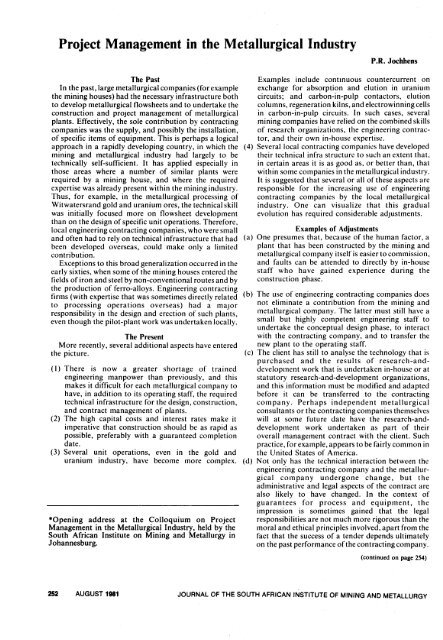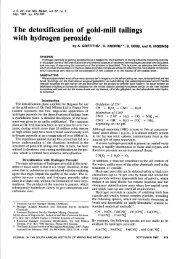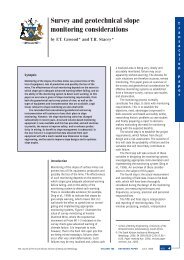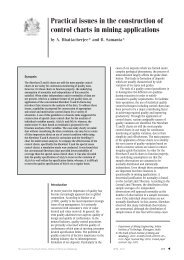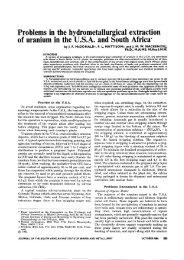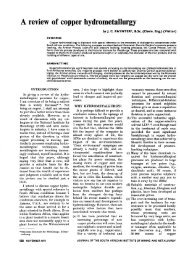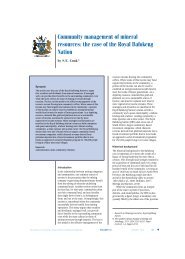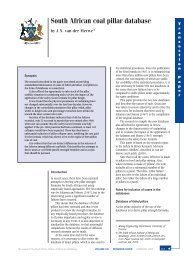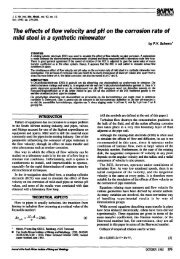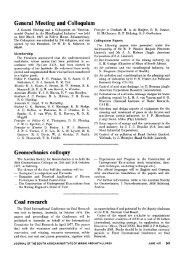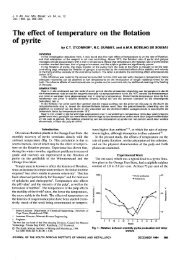Project Management in the Metallurgical Industry - saimm
Project Management in the Metallurgical Industry - saimm
Project Management in the Metallurgical Industry - saimm
You also want an ePaper? Increase the reach of your titles
YUMPU automatically turns print PDFs into web optimized ePapers that Google loves.
<strong>Project</strong> <strong>Management</strong> <strong>in</strong> <strong>the</strong> <strong>Metallurgical</strong> <strong>Industry</strong><br />
P.R. Jochhens<br />
The Present<br />
More recently, several additional aspects have entered<br />
<strong>the</strong> picture.<br />
(I) There is now a greater shortage of tra<strong>in</strong>ed<br />
eng<strong>in</strong>eer<strong>in</strong>g manpower than previously, and this<br />
makes it difficult for each metallurgical company to<br />
have, <strong>in</strong> addition to its operat<strong>in</strong>g staff, <strong>the</strong> required<br />
technical <strong>in</strong>frastructure for <strong>the</strong> design, construction,<br />
and contract management of plants.<br />
(2) The high capital costs and <strong>in</strong>terest rates make it<br />
imperative that construction should be as rapid as<br />
possible, preferably with a guaranteed completion<br />
date.<br />
(3) Several unit operations, even <strong>in</strong> <strong>the</strong> gold and<br />
uranium <strong>in</strong>dustry, have become more complex.<br />
*Open<strong>in</strong>g address at <strong>the</strong> Colloquium on <strong>Project</strong><br />
<strong>Management</strong> <strong>in</strong> <strong>the</strong> <strong>Metallurgical</strong> <strong>Industry</strong>, held by <strong>the</strong><br />
South African Institute on M<strong>in</strong><strong>in</strong>g and Metallurgy <strong>in</strong><br />
Johannesburg.<br />
Examples <strong>in</strong>clude contmuous countercurrent on<br />
exchange for absorption and elution <strong>in</strong> uranium<br />
circuits; and carbon-<strong>in</strong>-pulp contactors, elution<br />
columns, regeneration kilns, and electrow<strong>in</strong>n<strong>in</strong>g cells<br />
<strong>in</strong> carbon-<strong>in</strong>-pulp circuits. In such cases, several<br />
m<strong>in</strong><strong>in</strong>g companies have relied on <strong>the</strong> comb<strong>in</strong>ed skills<br />
The Past<br />
In <strong>the</strong> past, large metallurgical companies (for example<br />
<strong>the</strong> m<strong>in</strong><strong>in</strong>g houses) had <strong>the</strong> necessary <strong>in</strong>frastructure both<br />
to develop metallurgical tlowsheets and to undertake <strong>the</strong><br />
construction and project management of metallurgical<br />
plants. Effectively, <strong>the</strong> sole contribution by contract<strong>in</strong>g<br />
companies was <strong>the</strong> supply, and possibly <strong>the</strong> <strong>in</strong>stallation,<br />
of specific items of equipment. This is perhaps a logical<br />
approach <strong>in</strong> a rapidly develop<strong>in</strong>g country, <strong>in</strong> which <strong>the</strong><br />
m<strong>in</strong><strong>in</strong>g and metallurgical <strong>in</strong>dustry had largely to be<br />
technically self-sufficient. It has applied especially <strong>in</strong><br />
those areas where a number of similar plants were<br />
required by a m<strong>in</strong><strong>in</strong>g house, and where <strong>the</strong> required<br />
expertise was already present with<strong>in</strong> <strong>the</strong> m<strong>in</strong><strong>in</strong>g <strong>in</strong>dustry.<br />
Thus, for example, <strong>in</strong> <strong>the</strong> metallurgical process<strong>in</strong>g of<br />
Witwatersrand gold and uranium ores, <strong>the</strong> technical skill<br />
was <strong>in</strong>itially focused more on tlowsheet development<br />
than on <strong>the</strong> design of specific unit operations. Therefore,<br />
local eng<strong>in</strong>eer<strong>in</strong>g contract<strong>in</strong>g companies, who were small<br />
and often had to rely on technical <strong>in</strong>frastructure that had<br />
been developed overseas, could make only a limited<br />
contribution.<br />
Exceptions to this broad generalization occurred <strong>in</strong> <strong>the</strong><br />
early sixties, when some of <strong>the</strong> m<strong>in</strong><strong>in</strong>g houses entered <strong>the</strong><br />
fields of iron and steel by non-conventional routes and by<br />
<strong>the</strong> production of ferro-alloys. Eng<strong>in</strong>eer<strong>in</strong>g contract<strong>in</strong>g<br />
firms (with expertise that was sometimes directly related<br />
(b) The use of eng<strong>in</strong>eer<strong>in</strong>g contract<strong>in</strong>g<br />
to process<strong>in</strong>g operations overseas) had a major<br />
responsibility <strong>in</strong> <strong>the</strong> design and erection of such plants,<br />
even though <strong>the</strong> pilot-plant work was undertaken locally.<br />
of research organizations, <strong>the</strong> eng<strong>in</strong>eer<strong>in</strong>g contractor,<br />
and <strong>the</strong>ir own <strong>in</strong>-house expertise.<br />
(4) Several local contract<strong>in</strong>g companies have developed<br />
<strong>the</strong>ir technical <strong>in</strong>fra structure to such an extent that,<br />
<strong>in</strong> certa<strong>in</strong> areas it is as good as, or better than, that<br />
with<strong>in</strong> some companies <strong>in</strong> <strong>the</strong> metallurgical <strong>in</strong>dustry.<br />
It is suggested that several or all of <strong>the</strong>se aspects are<br />
responsible for <strong>the</strong> <strong>in</strong>creas<strong>in</strong>g use of eng<strong>in</strong>eer<strong>in</strong>g<br />
contract<strong>in</strong>g companies by <strong>the</strong> local metallurgical<br />
<strong>in</strong>dustry. One can visualize that this gradual<br />
evolution has required considerable adjustments.<br />
Examples of Adjustments<br />
(a) One presumes that, because of <strong>the</strong> human factor, a<br />
plant that has been constructed by <strong>the</strong> m<strong>in</strong><strong>in</strong>g and<br />
metallurgical company itself is easier to commission,<br />
and faults can be attended to directly by <strong>in</strong>-house<br />
staff who have ga<strong>in</strong>ed experience dur<strong>in</strong>g <strong>the</strong><br />
construction phase.<br />
companies does<br />
not elim<strong>in</strong>ate a contribution from <strong>the</strong> m<strong>in</strong><strong>in</strong>g and<br />
metallurgical company. The latter must still have a<br />
small but highly competent eng<strong>in</strong>eer<strong>in</strong>g staff to<br />
undertake <strong>the</strong> conceptual design phase, to <strong>in</strong>teract<br />
with <strong>the</strong> contract<strong>in</strong>g company, and to transfer <strong>the</strong><br />
new plant to <strong>the</strong> op.erat<strong>in</strong>g staff.<br />
(c) The client has still to analyse <strong>the</strong> technology that is<br />
purchased and <strong>the</strong> results of research-anddevelopment<br />
work that is undertaken <strong>in</strong>-house or at<br />
statutory research-and-development organizations,<br />
and this <strong>in</strong>formation must be modified and adapted<br />
before it can be transferred to <strong>the</strong> contract<strong>in</strong>g<br />
company. Perhaps <strong>in</strong>dependent metallurgical<br />
consultants or <strong>the</strong> contract<strong>in</strong>g companies <strong>the</strong>mselves<br />
will at some future date have <strong>the</strong> research-anddevelopment<br />
work undertaken as part of <strong>the</strong>ir<br />
overall management contract with <strong>the</strong> client. Such<br />
practice, for example, appears to be fairly common <strong>in</strong><br />
<strong>the</strong> United States of America.<br />
(d) Not only has <strong>the</strong> technical <strong>in</strong>teraction between <strong>the</strong><br />
eng<strong>in</strong>eer<strong>in</strong>g contract<strong>in</strong>g company and <strong>the</strong> metallurgical<br />
company undergone change, but <strong>the</strong><br />
adm<strong>in</strong>istrative and legal aspects of <strong>the</strong> contract are<br />
also likely to have changed. In <strong>the</strong> context of<br />
guarantees for process and equipment, <strong>the</strong><br />
impression is sometimes ga<strong>in</strong>ed that <strong>the</strong> legal<br />
responsibilities are not much more rigorous than <strong>the</strong><br />
moral and ethical pr<strong>in</strong>ciples <strong>in</strong>volved, apart from <strong>the</strong><br />
fact that <strong>the</strong> success of a tender depends ultimately<br />
on <strong>the</strong> past performance of <strong>the</strong> contract<strong>in</strong>g company.<br />
(cont<strong>in</strong>ued on page 254)<br />
252 AUGUST 1981 JOURNAL OF THE SOUTH AFRICAN INSTITUTE OF MINING AND METALLURGY
OBITUARY: AUSTIN WHILLIER<br />
(1927 - 1981)<br />
On Thursday, 13th August, 1981, Dr. Aust<strong>in</strong> Whillier<br />
passed away peacefully <strong>in</strong> Johannesburg after a long<br />
illness. This event has been a serious blow <strong>in</strong>deed, and its<br />
effects will be felt, not only by <strong>the</strong> Chamber of M<strong>in</strong>es of<br />
South Africa and <strong>the</strong> South African m<strong>in</strong><strong>in</strong>g <strong>in</strong>dustry, but<br />
also throughout many scientific and technical spheres<br />
both <strong>in</strong> South Africa and fur<strong>the</strong>r afield.<br />
Aust<strong>in</strong> Whillier was born <strong>in</strong> Vrede, <strong>in</strong> <strong>the</strong> Orange Free<br />
State, <strong>in</strong> 1927, grew up <strong>in</strong> Germiston, and matriculated at<br />
<strong>the</strong> Johannesburg Technical High and Trade School<br />
(now <strong>the</strong> John Orr Technical High School). His<br />
undergraduate academic tra<strong>in</strong><strong>in</strong>g was at<strong>the</strong> University of<br />
<strong>the</strong> Witwatersrand, where, <strong>in</strong> addition to obta<strong>in</strong><strong>in</strong>g <strong>the</strong><br />
B.Sc. degree <strong>in</strong> Mechanical Eng<strong>in</strong>eer<strong>in</strong>g cum laude <strong>in</strong><br />
1947, and receiv<strong>in</strong>g <strong>the</strong> Bernard Price Prize as top student<br />
<strong>in</strong> his class, he was active <strong>in</strong> student affairs and sport.<br />
After a short period with <strong>the</strong> South African Council for<br />
Scientific i,lnd Industrial Research <strong>in</strong> Pretoria, dur<strong>in</strong>g<br />
which he was <strong>in</strong>volved <strong>in</strong> <strong>in</strong>vestigations <strong>in</strong>to unsteadystate<br />
heat transfer <strong>in</strong> build<strong>in</strong>gs, Aust<strong>in</strong> left to take up a<br />
Union of South Africa Post-graduate Scholarship at <strong>the</strong><br />
Massachusettes Institute of Technology. This period at<br />
M.I.T. saw <strong>the</strong> atta<strong>in</strong><strong>in</strong>g of more, and greater,<br />
achievements <strong>in</strong> <strong>the</strong> form of two higher degrees, Master<br />
of Science and Doctor of Science <strong>in</strong> mechanical<br />
eng<strong>in</strong>eer<strong>in</strong>g, as well as <strong>the</strong> Karl Taylor Compton prize for<br />
1953 as <strong>the</strong> student who contributed 'most to university<br />
life while ma<strong>in</strong>ta<strong>in</strong><strong>in</strong>g a high academic standard'.<br />
The content of his doctoral <strong>the</strong>sis, on <strong>the</strong> subject of solar<br />
energy, was so enlightened and so sound that it is still<br />
considered to be highly relevant today - so much so, <strong>in</strong><br />
fact, that it was recently published <strong>in</strong> book form. His<br />
JOURNAL OF THE SOUTH AFRICAN INSTITUTE OF MINING AND METALLURGY 1981 AUGUST 253
association with M.I.T. cont<strong>in</strong>ued for a fur<strong>the</strong>r year and a<br />
half after he obta<strong>in</strong>ed his doctorate, <strong>in</strong> <strong>the</strong> capacities of<br />
lecturer and research associate, and <strong>the</strong> teach<strong>in</strong>g<br />
activities of this period provided <strong>the</strong> roots for Aust<strong>in</strong><br />
Whillier's outstand<strong>in</strong>g ability as a teacher. Over <strong>the</strong> years<br />
s<strong>in</strong>ce <strong>the</strong>n, many a class at many a level has benefited<br />
from his patience and understand<strong>in</strong>g <strong>in</strong> <strong>the</strong> lecture<br />
<strong>the</strong>atre.<br />
Leav<strong>in</strong>g M.I.T. at <strong>the</strong> beg<strong>in</strong>n<strong>in</strong>g of 1955 Aust<strong>in</strong> rejo<strong>in</strong>ed<br />
<strong>the</strong> CSIR <strong>in</strong> Pretoria, where he served, first, as head of <strong>the</strong><br />
Refrigeration and Air Condition<strong>in</strong>g Division of <strong>the</strong><br />
National Mechanical Eng<strong>in</strong>eer<strong>in</strong>g Research Institute<br />
and, subsequently, as <strong>the</strong> first head of <strong>the</strong> Hydromechanics<br />
Division, be<strong>in</strong>g responsible for build<strong>in</strong>g up <strong>the</strong><br />
newly-<strong>in</strong>formed Division.<br />
In mid 1961, <strong>the</strong> overseas academic world called once<br />
aga<strong>in</strong>, and Aust<strong>in</strong> took up an appo<strong>in</strong>tment as Associate<br />
Pro~essor at McGilI University with <strong>the</strong> responsibility of<br />
gett<strong>in</strong>g go<strong>in</strong>g <strong>the</strong> newly-established experimental station<br />
located <strong>in</strong> Barbados, West Indies, which was engaged <strong>in</strong><br />
<strong>the</strong> development of equipment to utilize solar and w<strong>in</strong>d<br />
energy.<br />
His return to South Africa at <strong>the</strong> beg<strong>in</strong>n<strong>in</strong>g of 1965<br />
brought him back to <strong>the</strong> academic world, as Senior<br />
Lecturer <strong>in</strong> <strong>the</strong> Department of Mechanical Eng<strong>in</strong>eer<strong>in</strong>g<br />
at <strong>the</strong> University of <strong>the</strong> Witwatersrand. Formal<br />
<strong>in</strong>volvement with <strong>the</strong> University <strong>in</strong> this capacity was<br />
short, last<strong>in</strong>g only for <strong>the</strong> year 1965, but, subsequent to<br />
his leav<strong>in</strong>g to jo<strong>in</strong> <strong>the</strong> staff of <strong>the</strong> Research Organisation<br />
of <strong>the</strong> Chamber of M<strong>in</strong>es of South Africa, <strong>the</strong> University<br />
and many of its classes cont<strong>in</strong>ued to benefit from Aust<strong>in</strong>'s<br />
services, ei<strong>the</strong>r as an external lecturer <strong>in</strong> <strong>the</strong> Department<br />
of M<strong>in</strong><strong>in</strong>g Eng<strong>in</strong>eer<strong>in</strong>g, or as an external exam<strong>in</strong>er to <strong>the</strong><br />
School of Mechanical Eng<strong>in</strong>eer<strong>in</strong>g.<br />
In <strong>the</strong> course of his sixteen years with <strong>the</strong> Chamber of<br />
M<strong>in</strong>es, Aust<strong>in</strong> rose to be Director of <strong>the</strong> Environmental<br />
Eng<strong>in</strong>eer<strong>in</strong>g Laboratory, and throughout brought his<br />
brilliant analytical m<strong>in</strong>d to bear on <strong>the</strong> problems<br />
encountered <strong>in</strong> <strong>the</strong> cool<strong>in</strong>g and ventilat<strong>in</strong>g of deep and<br />
hot m<strong>in</strong>es. In both <strong>the</strong>se areas, and <strong>in</strong> <strong>the</strong> various aspects<br />
<strong>the</strong>y encompass, great strides were made by Aust<strong>in</strong> and<br />
his team. In particular, <strong>the</strong> new method of cool<strong>in</strong>g m<strong>in</strong>es<br />
that was formulated, and has proved so successful that it<br />
is be<strong>in</strong>g adopted <strong>in</strong>creas<strong>in</strong>gly by South African m<strong>in</strong>es<br />
must be s<strong>in</strong>gled out as an outstand<strong>in</strong>g achievement, a~<br />
<strong>in</strong>valuable asset to <strong>the</strong> m<strong>in</strong><strong>in</strong>g <strong>in</strong>dustry worldwide, and a<br />
fitt<strong>in</strong>g monument to Aust<strong>in</strong>'s ability.<br />
In recognition of this achievement <strong>in</strong> <strong>the</strong> field of cool<strong>in</strong>g<br />
of m<strong>in</strong>es, Aust<strong>in</strong> was awarded <strong>the</strong> National Award oft~e<br />
Associated Scientific and Technical Societies <strong>in</strong> 1~17.<br />
O<strong>the</strong>r important awards and honours that came to him <strong>in</strong><br />
recent years <strong>in</strong>clude <strong>the</strong> silver medal of<strong>the</strong> South African<br />
Institution of Mechanical Eng<strong>in</strong>eers <strong>in</strong> 1968 and <strong>the</strong> gold<br />
medal of <strong>the</strong> M<strong>in</strong>e Ventilation Society of South Africa, as<br />
co-w<strong>in</strong>ner, 1973. In addition, close on a hundred papers<br />
have appeared <strong>in</strong> <strong>the</strong> technical press, bear<strong>in</strong>g <strong>the</strong> name of<br />
Aust<strong>in</strong> Whillier ei<strong>the</strong>r as author or co-author, and<br />
cover<strong>in</strong>g a very wide range of subjects.<br />
Aust<strong>in</strong> Whillier's contributions to progress <strong>in</strong> technical<br />
and scientific spheres have not been limited to those<br />
which arose <strong>in</strong> his normal l<strong>in</strong>e of duty, and his years of<br />
hard work for various technical and scientific bodies bear<br />
witness to this. He was Past-President of <strong>the</strong> M<strong>in</strong>e<br />
Ventilation Society of South Africa, The South African<br />
Institution of Mechanical Eng<strong>in</strong>eers, The Associated<br />
Scientific and Technical Societies of South Africa, and<br />
<strong>the</strong> Solar Energy Society of Sou<strong>the</strong>rn Africa.<br />
The untimely pass<strong>in</strong>g of Aust<strong>in</strong> Whillier is <strong>in</strong>deed a tragic<br />
loss that will be felt widely now and <strong>in</strong> <strong>the</strong> futurc. He is<br />
survived by his wife Mary. daughter Muffy, and sons<br />
John and Stephen; to <strong>the</strong>m we all offer our deepest<br />
sympathy.<br />
(cont<strong>in</strong>ued from page 252)<br />
<strong>Project</strong><br />
management<br />
Technical Infrastructure<br />
F<strong>in</strong>ally, although <strong>the</strong> metallurgical and m<strong>in</strong><strong>in</strong>g<br />
<strong>in</strong>dustry can <strong>in</strong>creas<strong>in</strong>gly rely on eng<strong>in</strong>eer<strong>in</strong>g contract<strong>in</strong>g<br />
companies to undertake a larger proportion of<strong>the</strong> design<br />
and construction of plants than <strong>in</strong> <strong>the</strong> past, <strong>the</strong> technical<br />
<strong>in</strong>frastructure of <strong>the</strong> client has to rema<strong>in</strong> high. This is to<br />
ensure that modifications to flowsheets and unit<br />
'operations on exist<strong>in</strong>g plants, particularly for improved<br />
control and optimization, are made as <strong>the</strong> technology<br />
improves. Therefore, technical expertise has to rema<strong>in</strong><br />
high <strong>in</strong> both parties, and <strong>the</strong> shortage of eng<strong>in</strong>eers will<br />
rema<strong>in</strong> a problem for both.<br />
254<br />
AUGUST 1981 JOURNAL OF THE SOUTH AFRICAN INSTITUTE OF MINING AND METALLURGY


